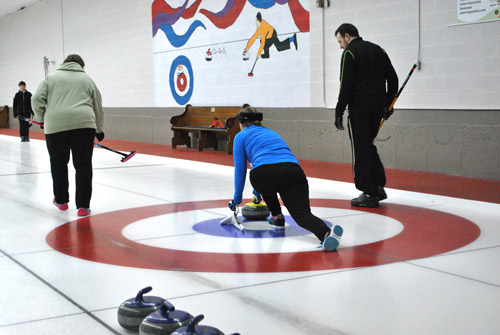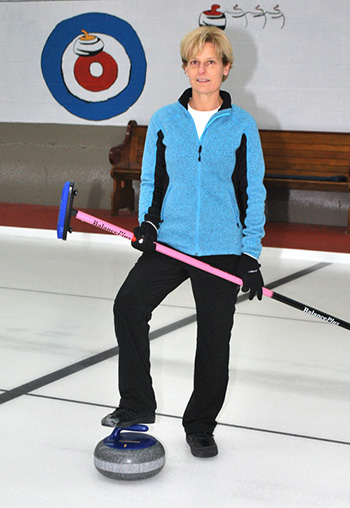| Let's Go Curling! | |||||||||
| by Sue Gillis | |||||||||
photo: Jan Doerler |
|||||||||
|
The Scots invented curling—along with golf, competitive bag piping, and single malt scotch. (Where else can you find tours designed just to drink your way through a country?) Though curling is still practiced in Scotland, it is most firmly established in Canada. Ninety percent of the world’s one-million-plus curlers are Canadian, making curling a significant part of Canadian culture. Scottish immigrants, many of them members of the military and railroad workers, spread the game throughout Canada, starting in 1750. The first curling club in Canada was the Royal Montreal Curling Club, established in 1807; in 1890 it became the first club in the world to admit women. It was also in 1890 that Canadian women held their first intercity Bonspiel (competitive event) between Montreal and Quebec. The Royal Caledonian CC in Perth, Scotland’s oldest curling club still in existence, admitted women in 1895.
Mention curling to your average US citizen, and you’ll likely get an eye roll, followed by a snarky remark such as “anyone who runs up and down the ice sweeping a broom alongside a rock must be odd. ” Nonetheless, curling has a longer history in the US than some Americans might realize. The first curling club was established in 1831 in Michigan. From there curling spread to Wisconsin, Minnesota, and North Dakota, where most of the US clubs and curlers are today. The Milwaukee Curling Club established in 1845 is the oldest continually operating club in the country; women were finally admitted in 1948. Though still thought of as peculiar and boring in the US, curling is slowly gaining popularity. Today, there are 135 US curling clubs in 20 states with approximately 15,000 members. In 1946, American women curlers established the US Women’s Curling Association, which has 66 clubs and over 3,000 members. Vermont has four curling clubs, most founded in the 1990s: Green Mountain Curling Club, Rutland Rocks Curling Club, Equinox Curling Club in Manchester, and Upper Valley Curling/Woodstock Curling Club. The Vermont clubs all rent local rinks rather than owning their own spaces.
It was a lengthy process establishing curling as an official Olympic winter sport. For decades, curling was only intermittently represented at the Olympics as a demonstration sport, the first time at Lake Placid in 1932 and twice more in 1988 and 1992. It took 10 years (1957 to 1967) to establish an international curling organization—a prerequisite for applying for Olympic medal status. Finally, in July 1992, curling got the Olympic go-ahead, and in 1998, it became part of the official program of the Olympic Winter Games at Nagano, with both men and women competing. Eva Muirhead, a 25-year-old Scot, who is one of the best curlers in the world, led her team to multiple World Curling Championships, finally winning the Bronze at the 2014 Sochi Olympics. Muirhead, by the way, is also a scratch golfer and a competitive bagpiper. A trifecta of Scottish accomplishments.
Two Vermont Woman staff members recently decided to take a closer look at curling. We drove to Bedford Curling Club in Quebec and met up with members of the Green Mountain Curling Club (GMCC) for a demonstration and on-the-ice instruction. GMCC president Connie Dollinger, vice president Bill Germer, and board member Mike Sitko welcomed us on arrival, and we were soon joined by a group of Vermont Penn State alumni who were also anxious to learn the game. We gathered at a bar and restaurant at the club, where ongoing games can be viewed through large windows that overlook the ice rink. This setting is consistent with curling clubs worldwide. Sportsmanship and sociability are integral to the curling culture, so much so that winners are obliged by the rules to buy losers drinks after the game. Curling has come a long way since 1511, when sturdy, gregarious Scots slid smooth, odd-shaped riverbed rocks on the frozen lochs and marshes of Scotland, just for winter fun. Though often described as playing shuffleboard or bowling on ice, curling has many more nuances. The game may appear simple but requires fitness, agility, and balance, as well as self-discipline, persistence, patience, cooperation, and humor. The best players and teams must master a multitude of defensive strategies to be executed aggressively. The World Federation of Curling, located in Perth, Scotland, establishes the rules. Today, the game is played indoors on a meticulously prepared pebbled ice sheet 146–150 feet long by 14–16 feet wide with colorful bull’s-eye targets on the sheet at either end. Two opposing teams, each with four teammates, take turns throwing a 42 lb. granite stone with a handle down the ice sheet toward the target. The pebbled ice provides friction, which makes it possible to curl, or turn, the stone to a better position, guiding it toward the target. Each player shoots twice. The team captain—called the skip—is responsible for calling (yelling, really) the direction of the throw and the sweeping action. Once thrown, two teammates follow the stone to the target, sweeping their brooms in front of it, following the directives of the yelling skip. There are 10 ends (innings) in each game. Each team has eight stones. After all 16 stones have been delivered, the team who has the most stones closest to or on the bull’s-eye, called the button, wins. Curling shoes include one Teflon sole for sliding, which definitely takes training. Adding to the challenge, the rink was bone-chilling cold, and the roar of the stones traveling across the ice and the yells of the skips were very loud. Yet we had fun. After several attempts at throwing and sliding, we began to get our ice legs, and by the second hour, we were ready to play a real game. We learned the basic terms, the equipment, the rules, scoring, and the physical feel of the game. After hearty congratulations to our opponents and handshakes all around, we headed for the bar for the traditional round of drinks.
|
|||||||||
| is the Publisher of Vermont Woman
|
|||||||||




